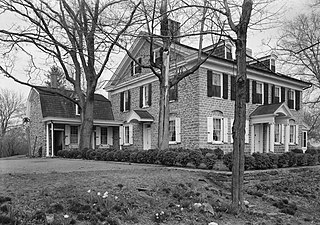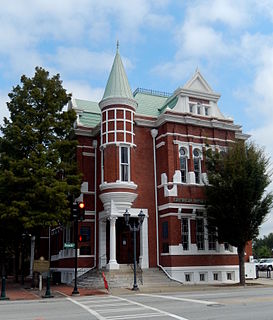
The Ashland Place Historic District is a historic district in the city of Mobile, Alabama, United States. The neighborhood gained its name from a Greek Revival antebellum house called Ashland that once stood on Lanier Avenue. Ashland was famous as the home of Augusta Evans Wilson. The house burned in 1926. The Ashland Place Historic District was placed on the National Register of Historic Places on June 23, 1987. It is roughly bounded by Spring Hill Avenue, Ryan Avenue, Old Shell Road, and Levert Avenue. The district covers 400 acres (1.6 km2) and contains 93 contributing buildings. The majority of the buildings date to the early 20th century and cover a variety of historical architectural styles ranging from late Victorian to the Craftsman styles.

The Montford Area Historic District is a mainly residential neighborhood in Asheville, North Carolina that is included in the National Register of Historic Places.
Moore House or Moore Farm may refer to:
Mills House may refer to:

Dr. William B. Pritchard House is a historic home located at Princess Anne, Somerset County, Maryland. It is a 2 1⁄2-story, five-bay, frame dwelling constructed in several stages between about 1860 and 1906. It features a porch with a distinctive octagonal gazebo. A traditional 19th-century farmhouse, it was reworked extensively around 1904–1906 in the Colonial Revival style by New York physician, Dr. William B. Pritchard as a country retreat.

Madison Historic District in Madison, Georgia is a historic district that was listed in the National Register of Historic Places in 1974. Its boundaries were increased in 1990 and it then encompassed 356 contributing buildings, three other contributing structures, four contributing objects, and three contributing sites.

William Henry Ludlow House is a historic home located at Claverack in Columbia County, New York, next to the Ludlow-Van Rensselaer House. It was built in 1786 and is a Georgian-style residence. It is a 2 1⁄2-story, five-bay center-entrance, brick dwelling. The south facade features a finely crafted Palladian window. Also on the property are four large stone gate posts and an original mile marker. There are 10 fireplaces. Outbuildings include the original summer kitchen, root cellar, ice house and a new carriage house. The house underwent a historically-correct restoration in 2011.

The William H. Moore House, also known as the Stokes-Moore Mansion and once home to the America-Israel Cultural Foundation, is a historic building located in New York, New York. The building was designed by the architecture firm McKim, Mead & White and built between 1898 and 1900. It is a five-story, rectangular stone building in the Renaissance Revival style. It has an English basement and flat roof with balustrade and overhanging cornice. It was commissioned by William Earle Dodge Stokes (1852–1926), and purchased by financier William Henry Moore (1848-1923) before its completion. His wife resided in the house until her death in 1955, after which it housed a succession of commercial and charitable organizations, including the Banco di Napoli.
Albert Anthony Ten Eyck Brown (1878–1940) was an architect active in Atlanta, Georgia and other areas. Brown was born in Albany, New York. He studied at the New York Academy of Design.
Lloyd B. Greer was an American architect who practiced in Valdosta, Georgia during the first half of the twentieth century. A number of the many hundreds of buildings that he is credited with designing are listed on the U.S. National Register of Historic Places.
Leon C. Goodrich was an American architect of Casper, Wyoming. A number of his works are listed on the National Register of Historic Places.

Moore Hall, also known as the William Moore House, is a historic home located in Schuylkill Township, Chester County, Pennsylvania. The house dates back to about 1722, and is a 2 1⁄2-story, five-bay by three-bay, fieldstone dwelling in the Georgian style. It has a gable roof, two-story rear kitchen wing and sun porch. It was restored in the late-1930s. During the American Revolution the house served as headquarters for Col. Clement Biddle in late-1777 and early-1778, during the encampment at Valley Forge. At that time, a committee of congress met at Moore Hall for three months and there decided that Gen. George Washington should serve as Commander in Chief of the Continental Army. At the turn of the 20th century, the house was the summer home for Pennsylvania Gov. Samuel W. Pennypacker.

Broadacres is a subdivision in Houston, Texas within the Boulevard Oaks community. It is located north of Bissonnet Street, south of U.S. Route 59, west of the Houston Museum District, and east of other subdivisions of Boulevard Oaks. The neighborhood is known for its large lots, historic preservationism, broad tree canopies, wide streets with medians, and affluence.

The Sidney Lanier Cottage is a historic cottage on High Street in Macon, Georgia, that was the birthplace of poet, musician, and soldier Sidney Lanier. Sidney Lanier Cottage was purchased by the Middle Georgia Historical Society in 1973, and opened to the public in 1975. The Sidney Lanier Cottage now serves as a museum, event space, and home of the Lanier Center for Literary Arts.

Augusta Cotton Exchange Building is a historic building in Augusta, Georgia. It was designed by Enoch William Brown and built in the mid-1880s during a cotton boom. The structure includes ornate details and ironwork and is considered High Victorian architecture. Materials for its construction were supplied locally by Charles F. Lombard's foundry. It was added to the National Register of Historic Places on July 20, 1978. It is located on Reynolds Street.

The Felton House, also known as Billy Place, is a historic residence in Marshallville, Georgia. It was added to the National Register of Historic Places on November 25, 1980. It is located on Route 1.

The 1774 Alexander Rock House in Charlotte, North Carolina is the oldest house in Mecklenburg County, North Carolina and was named to the National Register of Historic Places in 1970. Originally built by the Alexander Family who finished construction in 1774, the Rock House and its various outbuildings have had many owners over the years with The Charlotte Museum of History being its steward today.

The Macon Historic District is a historic district in Macon, Georgia that was listed on the National Register of Historic Places in 1974 and was expanded in 1995. The original listing covered 587 acres (238 ha) and included 1,050 contributing resources; the increase added 101 acres (41 ha) and 157 contributing resources.

Jenkins County Courthouse is a historic county courthouse in Millen, Georgia. Designed in a Neoclassical Revival architecture style by L.F. Goodrich, it was built in 1910. Unlike most courthouses in Georgia of the period, this one is three stories tall. It has columns that are plain and fluted, which are on high bases. The building has a bracketed cornice. On top is a copper-domed clock tower. It was added to the National Register of Historic Places on September 18, 1980.

Ellamae Ellis League, was an American architect, the fourth woman registered architect in Georgia and "one of Georgia and the South's most prominent female architects." She practiced for over 50 years, 41 of them from her own firm. From a family of architects, she was the first woman elected a Fellow of the American Institute of Architects (FAIA) in Georgia and only the eighth woman nationwide. Several buildings she designed are listed on the National Register of Historic Places (NRHP). In 2016 she was posthumously named a Georgia Woman of Achievement.
















